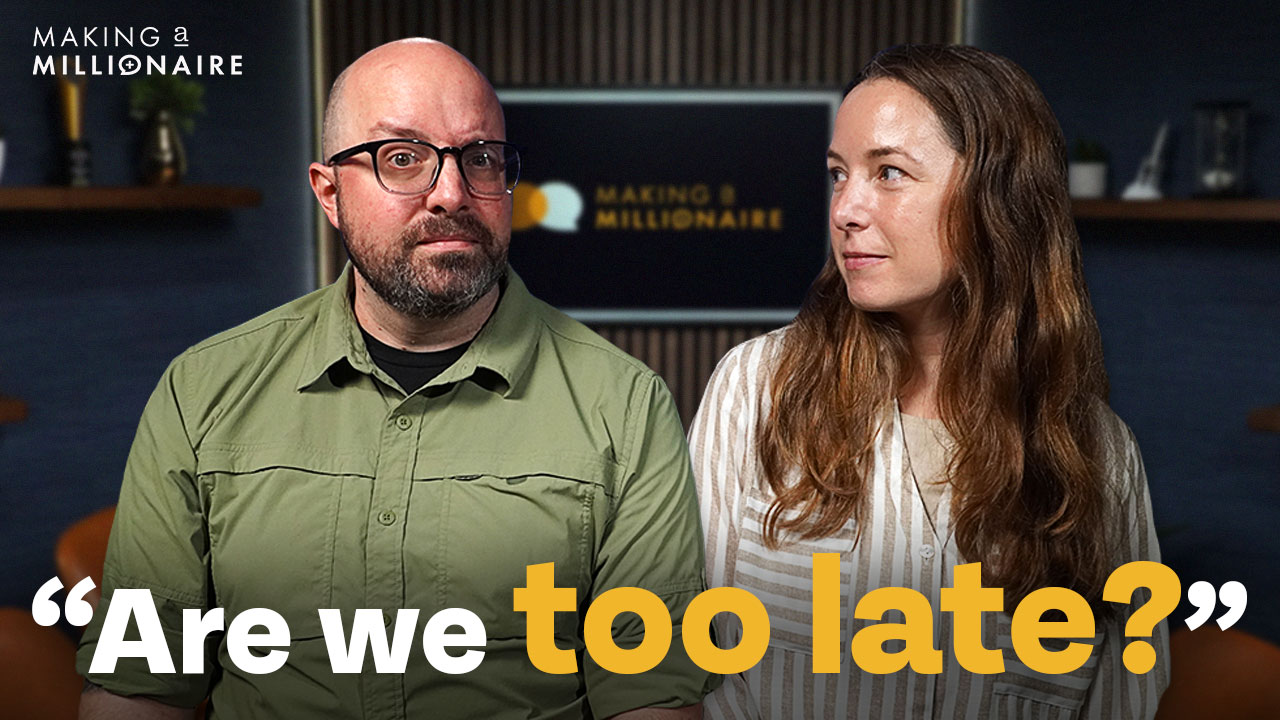So, alright, we’ve talked a little bit about debt and some of Dave’s views on debt. Let’s flip the script a little bit. Let’s look at maybe some of the stuff that he says around investing and building wealth. Check this out. This question comes from Thomas in Colorado. He says, “I’m struggling to know how much we actually need to retire. I’m 54 and currently have 1.4 million in a 401k, which sounds like a lot to me, but I don’t actually know how fast we’ll burn through that. So, if you’re invested in good growth stock mutual funds, I split my personal 401k. Jade does two, among four types: growth, growth and income, aggressive growth, and international. And over the last 30 years, my little portfolio of that has averaged over 12%, most years over 13.3%. Wow, Dave, that’s great, but it’s not really hard to beat the S&P. The S&P average of the market, so what do you want? I always kind of want to be above average. Hello, the stock market has averaged 11.8% since it began, the standard and poor. So let’s just pretend you’re making 11%. We’ll round down for the people that go bananas when I start talking about this stuff. Alright, so we’re going to round down. You’re making 11%. Alright, if you left three in there, that would, so that it would grow a little bit to cover some inflation and pulled off eight. Uh, that means you’d be living on $90,000 a year. Can you do that? The account is growing by 3% a year if it averages an 11% rate of return. Also, good point. So you’re still getting more money. Never burns up. It runs in perpetuation, so you’re not going to run out of money. You’re going to be fine. You know, some of the wonky Certified Financial Pharisees types, you know, they go bananas on that calculation. That’s us, I guess. The Certified Financial Feres is what he called us. Dave, we are friends. Dave, it sounds great, though. I got to Dave is a natural branding machine. I mean, because that, to say that. But Bo, there is so much here to unpack. First of all, the S&P 500 is not average, and you want to beat the average. I always tell people this whole thing of law of accelerating returns and human nature’s desire to innovate and grow, and always say, “Just don’t try to beat the market. Be the market.” Because, you know, this expansion is something you can prosper off of, and that’s why we love index investing. But to say that it’s average, I don’t think Dave has actually pulled the data on that, because what from our own research, if you go look at SPIVA and look at the data points, 93.1% of all domestic equity funds underperform the index. And he’s talking about, he said, “It’s just not that hard to beat the S&P 500,” and yet people that are paid hundreds of thousands, maybe million dollars a year to do this professionally can’t do it. 93% over a 10-year period underperform their stated index. It sounds to me like beating the market is indeed a difficult thing to do.
Well, I just would encourage people don’t try to be because even in the data I’ve followed, if you go look at the same SPIVA research, they not only show you, because you can do quick math and see 6.9% of advisers, I mean, of managers actually did overperform. So Dave is saying that he’s the one that chose that 6.9%, but if you go read the research, consistency is just not there, meaning that if you have a fund that did really good in this 10-year period, and you did another rolling period a few years in the future, there’s a very large likelihood that this 6.9% isn’t going to be the same funds, because consistency of beating the indexes is just so hard to do. So I would just say don’t waste the calories. I like index investing.
Now I’d like to move to something else Dave talked about because, man, there was a lot to unpack there. He talked about that you can pretty much count on you’re going to make 12% on your investments. And then he did this weird math where he said he rounded down to 11 for us. I’ve heard 12 for years from him, but he rounded down to 11 for us Pharisees. And then he said, you know, we got inflation at 3%, so you can have a safe withdrawal rate of 8%. And the only way he can do that is that you have to be just Wildcat crazy with your allocation. And Dave was because he’s 100% equity, even for somebody who’s at the threshold of retirement. And let’s, Bo, would you mind reviewing what was the allocation he said?
Yeah, so let’s walk through what Dave said. He said that when he comes to designing a portfolio, you should do 25% growth and income, 25% growth, 25% aggressive growth, and 25% international, all equities, all on the aggressive side. So he said, “All right, let’s check and see what does this portfolio actually look like.” So we went and we picked some funds, and we said, “Okay, let’s look at a handful of funds to determine if we could build what we’re going to call the Ramsey portfolio,” looking at the asset classes as he defines them. And these are the four funds that we’re looking at. We said, for growth and income, let’s use the Columbia Large Cap Index. For the growth fund, let’s use a JP Morgan Mid-Cap Growth. For aggressive growth, let’s use the Frank Small Cap Growth. We’re using different market capitalizations here, so we get some diversification, trying to give them the benefit of the doubt. And if international, let’s use the American Funds Europacific Growth Fund. So a lot of you are going to say, “Well, this all comes down to the data. Did you guys cherry-pick the worst-performing investment you could for Dave to put him at a disadvantage?” No, we actually did the exact opposite. We cherry-picked. We ran screens, did some research, these between these different categories, growth and income, growth, aggressive growth, and international. We try to look at, as we are commission advisers, what’s the best things we can go out there and buy for our clients, try to give them the best chance of doing this. I wouldn’t even be surprised if this wasn’t something that Dave had in his own portfolio. So I’d be in the comments, let us know if you’ve had any experience with these. But we tried to give him the best shot of success as possible. And guess what the data showed? Bo, show them. That’s the thing about the Money Guy show. We show you the numbers. So look at this. If we look at this portfolio compared to the S&P 500 of the last 20 years, so starting in 2003 all the way to 2023, the S&P 500 would have annualized about 10 to 12%. This Ramsey portfolio only annualized 9.8%. So it basically almost matched the S&P. It did not, over the last 20 years, grossly outperformed the S&P. And we didn’t get to that 12-13% number that Dave threw out. So this is looking at the last 20 years. Well, what happens if we even back that down a touch more? Because what if we think about doing this or implementing this strategy over a 10-year period? Well, you can see over the last 10 years, from 2013 to 2023, the S&P 500 over that time is annualized over 14% per year. This Ramsey portfolio of 25% growth and income, 25% growth, 25% aggressive growth, and 25% international only annualized 10.8%. Again, don’t mishear us. We’re not saying those are bad rates of returns. What we are saying is they weren’t better than the S&P 500.
Yeah, and that’s the key takeaway is I think that actually Dave’s portfolios did great. I mean, so this could work. It’s pretty risky, but it did do great. I mean, it ties to the 11, close to the 11% that he was talking about. But to say that you can beat the S&P 500 consistently might be a bridge too far. And then I want to remind people, this is, let’s pull this back because we’re not talking about a portfolio for a 20-something. This is a caller that was at retirement, or were they even in retirement? They were nearing retirement, nearing retirement. Because when I look at this and we’re here, we are Certified Financial Pharisees, as Dave called us, certified financial planners, registered. We actually have to think about risk management, stress testing, making sure that clients get the best retirement experience. Not the “Hey, you retire, and hey, we messed up some things, and we told you you could pull out 8%, but reality is you better be firing up the pots of water, put some potatoes in there because you’re going to need to cut your expenses down because an 8% safe withdrawal rate is unrealistic.” You know, a lot of the time in financial planning, here’s a term that I would encourage anybody who thinks they’re going to do 8%, go out there and research what sequence of return risk is. Because unfortunately, I love that the S&P 500 does get close to 11% historically, but the fact that it’s missed there is that it’s not in these nice little prepackaged 11% annual boxes. You will have years that you’ll make 23, 24%. You’ll have years that you lose 12%. You’ll have years that you make 8%. It comes all over the place. Hence, why we diversify, hence why we plan for the long term. This type of strategy, doing 100% equity, assuming an 8% withdrawal rate, is very, very dangerous for retirees. And it’s not just anecdotal evidence. There have actually been people that have studied this. You perhaps have heard of the Trinity study where they said, “Hey, let’s look at different periods of time throughout history and see what withdrawal rate would have been sustainable giving different allocations to equities, giving different allocations to bonds, and what was a consistent withdrawal rate that would have weathered any time period.” And this was actually a study that was updated when they did the Trinity study a number of years ago, looking at 30-year retirements. And what they basically said is, if we look at rolling 30-year periods factoring in inflation, what withdrawal rate would give us the highest probability of success without running out of money? And the conclusion they came at that is a withdrawal rate somewhere around 4% is probably historically a sustainable, safe withdrawal rate. If you have some sort of diversified portfolio, we say some sort of diversified, that’s anywhere from 25% stocks up to 100% stocks, you would say that you have a greater than 75% probability of success of not running out of money. Now, when you factor in Dave’s 8% withdrawal rate and you run through this same study looking at 30-year time horizons, you can see that even a 100% stock portfolio, the most aggressive portfolio, which is pretty close to the allocation that Dave recommends, is less than a 50% success rate, meaning in less than 50% of scenarios would you have made it all the way to retirement without having to decrease that withdrawal rate. Well, then if you diversified your assets at all and went to 75% stocks or 50% stocks, the success rate dropped even further. And we’ve said a lot, Brian, that as you move to financial independence and as you move through retirement, your allocation should ultimately get more conservative. So it seems to me that Dave saying that an 8% withdrawal rate is sustainable over the long term just does not line up with the data.
Yeah, I know a number of you go listen to this on the podcast. You know, I go have the visuals in front of you, so I want to just make sure I give you the details. And I also encourage you go out to our YouTube channel and check this out. Go to Money Guy, and we have all that stuff published and posted there as well. But just for those that can’t see, for a 4% safe withdrawal rate and a diversification where at least 50%, because that’s what the Trinity study likes to draw attention to, a 50% equity portfolio and better, meaning greater than 50%. You’re probably still looking at the 4%, about 90% effective retire, you know, success rate. And that’s what if you were thinking about you’re doing a stress test, you’re running all these different scenarios. If you use a 4% safe withdrawal rate for a 30-year retirement, 90% likelihood of success. Go to the exact same data point with Dave’s, and now you’ve got a range between 25 and 45% success rate. For more information, check out our free resources.














